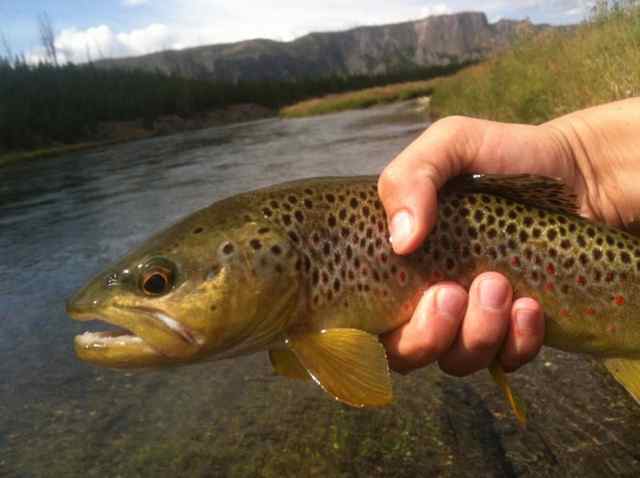
Report Date:
http://www.blue-ribbon-flies.comBy: Craig Mathews
September is a period of change for Yellowstone fishing. There are far fewer anglers around for sure. But, perhaps a more significant change is there are fewer insect emergences to fish too. Those fall hatches that do remain then become more significant. Yellowstone country's trout are always on the lookout for a good meal and anglers are searching for the corresponding rises of fish. And while there are fewer insect hatches now, those that do remain are important to know and be prepared to fish. Mayflies include Fall Baetis and Green Drakes, Mahogany Duns and Margaritas as well as Heptagenia sp. Caddis emergences in the late season are limited to the White Millers, Rhyacophila and Hydropsyche sps. while midges playing an ever increasing role to dry fly fishing here as other hatches begin to wane.
In September Callibaetis mayflies continue to emergence on stillwaters like Hebgen, Ennis, Earthquake, Hidden and Elk Lakes.
You might see Baetis on all Yellowstone rivers and streams while the big Fall Green Drakes will be on Slough Creek and the Lamar Rivers in fishable numbers. Mahogany Duns emerge on the Henry's Fork and Gallatin Rivers while Margaritas can be fished on the Madison and Yellowstone near Sulphur Cauldron and Otter Creek.
Caddisflies should be expected on the Firehole from late summer through October. Caddis like the White Miller and Hydropsyche will emerge daily and anglers should be prepared. On the Madison both in and outside the Park and Firehole River you may fish strong hatches of Rhyacophila in late summer and fall.
Of course terrestrials play a larger role now for the dry fly angler. Crickets, bees, hoppers, butterflies, ants and beetles should all be on your list to fish.
The late season is a special time for anglers too, especial most locals! Gone are the lines at gas pumps, grocery stores and the 2 stop-lights in our town. Those in-the-know begin to fish the big brown trout that the late season brings upriver from lakes like Hebgen in preparation for spawning. On lakes like Shoshone big brown trout may drop downstream into stream outlets like the Lewis to spawn. Big rainbows often follow the browns on their migrations too. And, not to be denied are fall-spawning brook trout.
Pictured Above: Peter Scorzetti took this shot just above Mt Haynes on the Madison in Yellowstone Park.
One thing for sure, fall fishing to pre-spawning trout requires special strategies and anglers must first realize how fickle this type of angling can be, and how tough planning to fish it is.
There are certain times these big fall-run fish can be taken on all fly types. We see so many anglers arriving planning on fishing nothing but big streamers and nymphs and while these methods are effective there are others that will produce better during the right times.
You must be ready to fish insect emergences that bring up rises of fall fish, emergences like we looked at above. As the fall season progresses there are other tactics to consider and we will look at them in future newsletters but for now make sure you are prepared to fish the insects we looked at above. Give us a call and we can line you up with a few flies and places to fish while you enjoy Yellowstone in the late season with its bugling elk, golden aspens and snow-capped mountains!
Our good friend Bobby Patrick just arrived to take advantage of some late season fishing. Make sure you check out his movie, "The Butler" which has topped the box office charts the past 3 weeks. Bobby and his friends will be fishing the Madison, Henrys Fork and smaller waters like Soda Butte and the Gardner River with us the next few days.
I just finished reading another good friends Doctoral Thesis, "Wolverine Ecology and Conservation in the Western United States". Bob Inman is its author and he did much of his research on these great animals in the Madison and Centennial Valleys of southwestern Montana. The last wolverine I saw was at Earthquake Lake last spring as it stalked bighorn sheep.
Beside the incredible knowledge of wolverines Bob has offered in his monumental thesis, another related thing I learned is that sportsmen contribute over $2.5 billion annually to wildlife conservation through the PR and Dingell-Johnson Acts of our Federal Government. Basically 10% of the purchase of hunting and fishing gear is distributed to state wildlife agencies where each dollar is matched by 3 license dollars. When combines with state hunting and fishing license sales, these sportsmen-generated dollars contribute these $2.5 billon. The funds have typically formed nearly 90% of state wildlife agency budgets.
We'll keep you informed most every week throughout the spring and summer to keep you tuned in to all things fly fishing and fly tying in the greater Yellowstone area and beyond. Throughout the seasons, we'll keep sending you news of hatches and fishing holes around West Yellowstone. So without further delay, go ahead and jump right into the newsletter. And as always, don't hesitate to give us a call or shoot us an email if you have any questions, or if you just want a little fish talk.